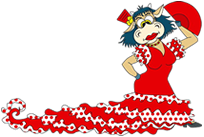Categories
- Flamenco Artsists and Figures
- Flamenco bars Tablaos and Pubs
- Flamenco Dictionary
- Flamenco Festivals
- Flamenco Folk Clubs
- Flamenco History
-
Flamenco Palos
- Andalusian Song
- Binary Metric
- Country Style
- Dance Songs
- First Songs
- Folkloric Branches
- Free Group
- Gipsy Song
- Latin American Branch
- Malaga Styles
- Metric Style of 12 Times
- Native Song
- Polyrhythmical Group
- Seguirya Group
- Solea Group
- Song of the Mine
- Song Without Guitar
- Songs from Levante
- Ternary Metric
- Record Companies
- Songs Lyrics
-
Romance, it belongs to the solea group, metrical system of 12 times.
-
Romance, it belongs to the solea group, metrical system of 12 times.
-
Romera, it belongs to the solea group, metrical system of 12 times. Flamenco song belonging to the Cantiñas de Cadiz group. Romero el "Tito", popular "cantaor" of the XIX. Century coming from Andalusia. He created a dancing style starting from an old Cantiña. He gave it his own name: Romera.
-
Romera, it belongs to the solea group, metrical system of 12 times. Flamenco song belonging to the Cantiñas de Cadiz group. Romero el "Tito", popular "cantaor" of the XIX. Century coming from Andalusia. He created a dancing style starting from an old Cantiña. He gave it his own name: Romera.
-
Romeras, they belong to the dancing songs, to the solea group and the metric style of 12 measures. Flamenco song of the Cantiñas de Cadiz group. Romero el "Tito", popular inger from XIX. century created this style on an old Cantiña. He gave it his name and it became "Romera".
-
Rondeñas, they belong to the Andalusian songs branch, styles from Malaga, they belong to the free styles. A "palo" originated in Ronda, a city of Malaga. As all the other flamenco "palos" comiing from Malaga, the "rondeña" is prior to the flamenco itself.
It is a copla made of four octosyllable lines, generally with a consonant rhyme. They normally turn into five by repetition of the second one, but also without repetition. It is a composition without "compas", of which lyrics are identified with the rural life. During the last years they evolved, they are less overelaborated with "melismas" and they are slower at the beginning. -
Rondeñas, they belong to the Andalusian songs branch, styles from Malaga, they belong to the free styles. A "palo" originated in Ronda, a city of Malaga. As all the other flamenco "palos" comiing from Malaga, the "rondeña" is prior to the flamenco itself.
It is a copla made of four octosyllable lines, generally with a consonant rhyme. They normally turn into five by repetition of the second one, but also without repetition. It is a composition without "compas", of which lyrics are identified with the rural life. During the last years they evolved, they are less overelaborated with "melismas" and they are slower at the beginning. -
Rumbas, they belong to the Latin American branch, to the tangos group and the measure is binary. "Aflamencado" songs belonging to the songs of "Ida y Vuelta". A musical rhythm like a dance style coming from Africa, through the slave trade to Cuba. The rumba arrived in Spain with the flamenca rumba and the Catalonian rumba. Connected to the "guaracha" more than with the Cuban rumba.
-
Rumbas, they belong to the Latin American branch, to the tangos group and the measure is binary. "Aflamencado" songs belonging to the songs of "Ida y Vuelta". A musical rhythm like a dance style coming from Africa, through the slave trade to Cuba. The rumba arrived in Spain with the flamenca rumba and the Catalonian rumba. Connected to the "guaracha" more than with the Cuban rumba.












